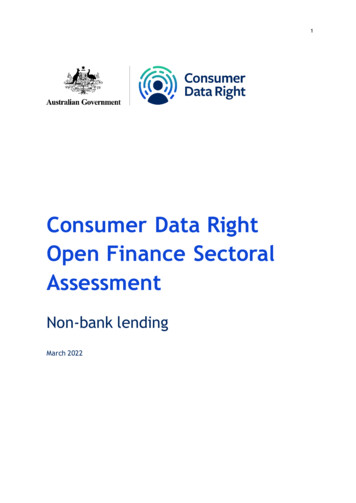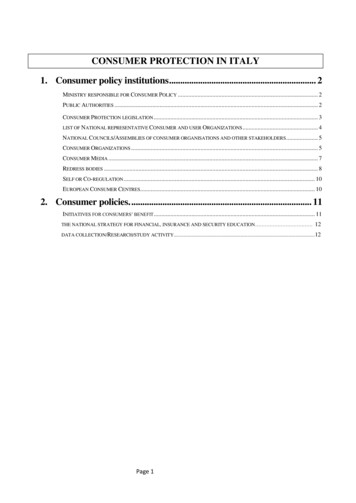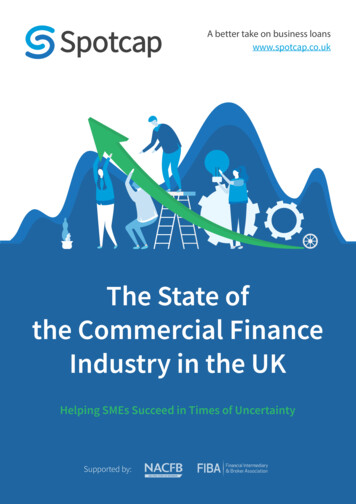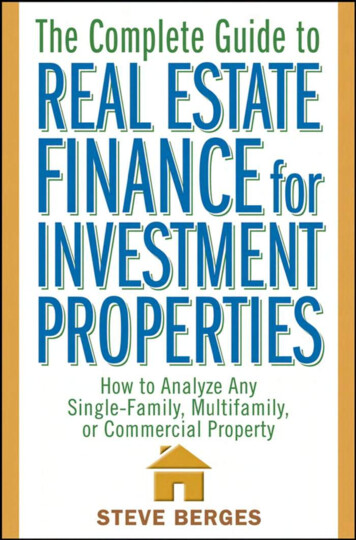
Transcription
1Consumer Data RightOpen Finance SectoralAssessmentNon-bank lendingMarch 2022
2Table of ContentsConsultation Process . 41. Introduction: Expansion to Open Finance . 61.1. The process for assessing and designating sectors and datasets. 91.2. The effect of designation .102. Non-bank lending in Australia . 112.1. Non-bank lending products.112.2. Potential to improve individual and small business outcomes .122.3. What non-bank lending data should be included in the designation? .14Intellectual property .152.4. What data holders might be suitable for designation? .162.5. Privacy and regulatory burden considerations .17Privacy and confidentiality .17Regulatory impact .173. Examples of rules considerations . 213.1. Eligible customers .213.2. Phasing of data sharing obligations .21Glossary . 22
3 Commonwealth of Australia 2022This publication is available for your use under a Creative Commons Attribution 3.0Australia licence, with the exception of the Commonwealth Coat of Arms, the Treasurylogo, photographs, images, signatures and where otherwise stated. The full licence termsare available from lcode.Use of Treasury material under a Creative Commons Attribution 3.0 Australia licencerequires you to attribute the work (but not in any way that suggests that the Treasuryendorses you or your use of the work).Treasury material used ‘as supplied’.Provided you have not modified or transformed Treasury material in any way including, forexample, by changing the Treasury text; calculating percentage changes; graphing orcharting data; or deriving new statistics from published Treasury statistics — then Treasuryprefers the following attribution:Source: The Australian Government the Treasury.Derivative materialIf you have modified or transformed Treasury material, or derived new material fromthose of the Treasury in any way, then Treasury prefers the following attribution:Based on The Australian Government the Treasury data.Use of the Coat of ArmsThe terms under which the Coat of Arms can be used are set out on the Department of thePrime Minister and Cabinet website (see ther usesEnquiries regarding this licence and any other use of this document are welcome at:ManagerMedia and Speeches UnitThe TreasuryLangton CrescentParkes ACT 2600Email: media@treasury.gov.au
4Consultation ProcessRequest for feedback and commentsInterested parties are invited to comment on the issues raised in this paper by12 April 2022.While submissions may be lodged electronically or by post, electronic lodgement ispreferred. For accessibility reasons, please submit responses sent via email in a Word orRTF format. An additional PDF version may also be submitted.Publication of submissions and confidentialityAll information (including name and address details) contained in formal submissions willbe made available to the public on the Australian Treasury website, unless you indicatethat you would like all or part of your submission to remain confidential. Automaticallygenerated confidentiality statements in emails do not suffice for this purpose.Respondents who would like part of their submission to remain confidential should providethis information marked as such in a separate attachment.Legal requirements, such as those imposed by the Freedom of Information Act 1982, mayaffect the confidentiality of your submission.Consultation process to support the sectoral assessmentTreasury’s consultation process for the sectoral assessment will involve consulting broadlywith representatives from the non-bank lending industry, industry associations, start-ups,consumer and privacy advocates and other interested parties.Feedback received during this process will inform a final report, which will make arecommendation to the Minister on whether to extend the Consumer Data Right tonon-bank lending. The sectoral assessment consultation process will also incorporateconsultation activities including a stakeholder roundtable and targeted bilateral meetings.Closing date for submissions: 12 April 2022Emaildata@treasury.gov.auMailSectoral AssessmentsConsumer Data Right DivisionThe TreasuryLangton CrescentPARKES ACT 2600EnquiriesEnquiries can be initially directed to data@treasury.gov.auPhoneClaire McKay, Director, 02 6263 2124Media enquiries should be directed to media@treasury.gov.au
5The principles outlined in this paper have not received Government approval and are notyet law. As a consequence, this paper is merely a guide as to how the principles mightoperate.
61.Introduction: Expansion to Open FinanceAustralia’s future prosperity will depend on how it adapts to changes in technology andthe digital frontier. The potential benefits of the digitalisation of the Australian economyhave been estimated at 315 billion over the next decade, 1 and will benefit all aspects ofAustralian society. The Consumer Data Right (CDR) is a key aspect of Australia’s DigitalEconomy Strategy 2030. The CDR is a new pillar of competition policy, aiming to enhancecompetition and innovation in key industries, especially service industries, which comprisea large share of the economy but may struggle with productivity growth. The CDR is also afundamental right for Australian consumers and businesses to have power over datagenerated about them, to share and extract value from this data and help to access themany benefits of progress in digital infrastructure and capability.On 24 January 2022, the Minister for Superannuation, Financial Services, the DigitalEconomy and Women’s Economic Security and the Treasurer announced that the nextpriority area for the economy-wide implementation of the CDR is expansion to ‘OpenFinance’ data, building on banking data that is already available, and energy andtelecommunications data which is being brought into the CDR. Expansion to Open Financewill be delivered in a phased approach to facilitate a more rapid and targeted approach todesignating the key datasets across each of these subsectors that build -on andcomplement existing designated datasets. Phase 1 expansion will also explore the extentto which there are complementary consumer datasets held by government and thebenefits for consumers having access to these datasets through the CDR.As announced, phase 1 of Open Finance will include the assessment and designation of thenon-bank lending sector, merchant acquiring services, and key datasets in the generalinsurance and superannuation sectors. This consultation paper invites feedback on theproposal to expand CDR to non-bank lending for the purpose of informing Treasury’ssectoral assessment report.Separate consultation processes will specifically explore the scope and merits of expansionto merchant acquiring services, general insurance and superannuation datasets. Theseconsultation processes have been designed to work together to facilitate feedback on thecombined effect of datasets across the four subsectors to deliver phase 1 of Open Finance,with particular regard to unlocking consumer-centric innovation while balancing the costof implementation and supporting accelerated ecosystem growth.In providing feedback, stakeholders are encouraged to consider how datasets across allfour areas along with data already in the CDR system could together support productinnovation, streamline business processes and improve consumer outcomes. Theassessment and designation of phase 1 of Open Finance will be completed in 2022. Thetiming and focus of any future phases will depend on the implementation of phase 1 andwill likely consider a broader range of datasets from the merchant acquiring services,superannuation and insurance subsectors.1Australian Government. Australia’s Digital Economy. 2021. Accessed June 2021 utive -summary
7Why Open Finance?Open Finance has been identified as the next priority area for expansion based on astrategic assessment conducted by Treasury in 2021 that explored how to best prioritiseand sequence economy-wide implementation. The findings of the assessment wereinformed by extensive consultation and published by Treasury on 24 January 2022. Thereport concludes that: Future expansion should be based on identifying key datasets that either alone orcombined with other datasets contribute to concrete consumer outcomes andbenefits. To support rapid growth of the innovation ecosystem the immediate focus shouldbe on datasets that build-on and complement existing datasets to support abroader range of use cases. Expansion of the CDR should be data holder agnostic and consider both consumerdata held by businesses and government as appropriate.Application of the CDR to Open Finance, including non-bank lending, can enhance theeconomic wellbeing of Australians by assisting individuals and businesses to switch tobetter-value deals that match their needs in products that fall within some of the mostfundamental areas of one’s life – banking, insurance and superannuation. Providing moreinformation about financial products reduces information asymmetries and can helpconsumers search for and compare a full set of financial products, and have greaterconfidence when dealing with the financial sector.Non-bank lendingNon-bank lending has clear parallels with the already designated banking sector, andcould provide consumers with a more complete view of their liabilities and borrowingand facilitate comparison of the full suite of lending products on the market, spurringmore competitive and personalised products and services across both the banking andnon-bank lending sectors.Merchant acquiring servicesMerchant acquiring services facilitate merchants to process payments and therefore arecritical to running a small business. Extension of the CDR to merchant acquiring servicescould improve transparency of product information and support product comparison,particularly for card transaction data. The Reserve Bank of Australia (RBA)’s Review ofRetail Payments Regulation found that this may address market inefficiencies, andreduce merchants’ search and switching costs.Cont. on next pageOpen Finance Sectoral Assessment7
8General insuranceThe lack of standardised information about general insurance products and servicesmakes it difficult for consumers to understand and assess the value and relevance forthem of competing product and services offerings, which can lead to consumers eitherpaying for products and services not well suited to their circumstances, underinsuranceor actions on their part that unwittingly invalidate their insurance policy. There aremany potential use cases that could support expansion of the CDR to a range of generalinsurance and other insurance type products and datasets. A phased approach toexpansion has been proposed based on early feedback about the potential forimmediate benefit from enhancing consumer access to an equivalent form of genericproduct data.SuperannuationSuperannuation often represents an individual’s most significant personal asset andtherefore is a significant element of consumer financial wellbeing. Enhanced access tokey consumer information such as superannuation account balances has beenhighlighted as an efficient way to increase consumer engagement with and knowledgeof their superannuation. When combined with other financial datasets, access to keyaccount information through the CDR could improve consumer’s understanding of theirfinances and support life-span wealth management.Government-held consumer dataExpanding the CDR to complementary government-held datasets may also significantlyenhance the user experience and utility of the CDR. Treasury is exploring the potentialfor the CDR to expand to government-held consumer datasets as part of Open Finance.Combining Open Finance with banking datasets already in the CDR could support thecreation of new and innovative services such as personal finance and life administrationapps to take the time, cost and complexity out of everyday tasks and make big financialdecisions less risky for consumers. Banking and non-bank lending data can be used forfinancial planning and loan assessment purposes, and an even richer picture of someone’sfinancial circumstances can be revealed when banking data is combined withsuperannuation and insurance data.More convenient data-driven services like budgeting and financial management apps canhelp consumers spend less time on ‘life admin’ and reduce transactio n costs. Combiningbanking and Open Finance datasets has the potential to support consumers to plan for andbetter manage significant financial events, such as applying for a home loan or makinglonger-term decisions about retirement.As more sectors are designated to the CDR, the possibilities from combining datasets grow,presenting greater opportunities for innovation and enhancing benefits to consumers.Accredited data recipients (ADRs) offering account aggregation services could bringtogether information about energy, telecommunications and financial services productsOpen Finance Sectoral Assessment8
9their customers hold with different providers in one place, providing consumers with aholistic picture of their finances and enabling consumers to better manage their householdservices. This could help consumers achieve savings goals, get better deals and changetheir consumption behaviours to better suit their lifestyle and needs.Ellyse manages her financesEllyse has accounts with multiple banks and non-bank lenders so she can getcompetitive interest rates on her loans and the best reward schemes from her creditcard providers. The implementation of Open Finance datasets means Ellyse can useCDR enabled budgeting apps to bring the data from her different accounts into oneeasy-to-use dashboard. She uses the dashboard to compare loans and credit card dealsacross different bank and non-bank providers.As well as finding the best loan and credit card rates, Ellyse can use data from energyand telecommunications providers to find better phone or electricity plans, whichhelps her to meet her loan repayment goals faster. Ellyse can also have her scheduledpayments included in the app, so it notifies her when payments are due or when sheshould move funds between her loan and deposit acco unts to reduce interestpayments.Account management tools are another way the data could be used, allowing a consumerto be notified by an ADR when their upcoming payments to both bank and non-banklenders are due, and to forecast when there may be difficulties making these paymentsahead of any amounts becoming overdue.1.1.The process for assessing and designating sectors and datasetsThe process for expanding the CDR to cover new sectors and datasets involves a formalassessment and designation process that is specified in legislation. Section 56AC of theCompetition and Consumer Act 2010 (the Act) empowers the relevant minister (theMinister for the Digital Economy) to make a legislative instrument designating a sector ofthe Australian economy to be subject to the CDR, and the specific classes of information(data) and the class or classes of persons who hold the designated information (dataholders). In doing so the Minister must consider the following factors: the interests of consumers; promoting competition; the efficiency of relevant markets; promoting data-driven innovation; the privacy or confidentiality of consumers’ information; any intellectual property in the information; the public interest; and the likely regulatory impact of designation.Open Finance Sectoral Assessment9
10To inform the Minister’s consideration of these factors, the Secretary of the Department(the Treasury) must provide a report addressing each of these factors informed by publicconsultation and consultation with the Australian Competition and Consumer Commission(ACCC), Office of the Australian Information Commissioner (OAIC), and the primaryregulator of the relevant sector (section 56AE(1)(c)). The Minister is also required toconsult the OAIC about the likely effect of the instrument on the privacy andconfidentiality of consumers’ information (section 56AD(3)).1.2.The effect of designationThe making of a designation instrument enlivens the rule-making power in relation to thesector by specifying the parameters for the classes of information that may be required tobe shared under the CDR in a particular sector, as well as who is required to share it.Once a sector has been designated, CDR rules and standards for that sector can be madein accordance with statutory processes, including extensive consultation requirements.Designation involves specifying ‘classes of information’ or data to be designated, butdesignation of a sector does not itself impose substantive obligations. Rather, therequirement to disclose particular data arises from the CDR rules, which establish what is‘required’ CDR data that must be shared in response to a valid request, as well as whatinformation data holders are ‘authorised’ to share on a voluntary basis. More informationon the operation of the CDR regulatory framework is available at Attachment A.Open Finance Sectoral Assessment10
112.Non-bank lending in AustraliaA non-bank lender and financier is a business that offers consumers – both individual andbusiness customers – loans, mortgages, personal finance, credit cards and other types offinance, but does not hold a banking license or accept deposits. Non-bank lending inAustralia continues to grow in both balance sheet size and range of products, in manycases offering specialised products to consumer segments that are not prioritised bybanks.Non-bank lending products are an increasingly important source of credit for individualconsumers and businesses. Consumers engage with a range of non-bank lending productsincluding credit cards, home loans, personal and business loans on a regular basis insteadof, and as well as, banking products supplied by authorised deposit-taking institutions(ADIs; commonly referred to as banks).Non-bank lenders are also active in the small business lending space. Approximately40 per cent of non-bank lenders’ loan volumes are sourced from business customers. 2Adding non-bank lending data into the CDR system could complement datasets alreadybeing shared in the banking sector and consumers including businesses will benefit fromthe ability to access and share CDR data in relation to the full range of credit and lendingproducts available in the market.2.1.Non-bank lending productsNon-bank lenders offer a range of products, including: Home loans: Typically the largest item on the balance sheet of non-bank lenders. Insome cases, the loans originated by these large non-bank lenders are securitised andsold to investors. Credit cards: Credit cards remain a common form of credit for Australian individualand business consumers; 19 per cent of Australian transactions are paid using a creditcard.3,4 Credit cards incur monthly interest charges on outstanding balances, as wellas potentially other fees, such as an annual fee. Personal loans: Non-banks are prominent in the personal loan segment, sometimesoffering specialised lending products to customers whose circumstances make themless suitable for banking products. These loans could be used to pay for smaller itemssuch as cars, holidays or home renovations and can be secured or unsecured. Thiscategory includes payday lenders or cash advance providers, who can quickly provideconsumers with short-term loans, but with high levels of fees attached that makethem more expensive than conventional personal loans.2Reserve Bank of Australia, RBA Statistical table: B10 Finance Companies and General Financiers, RBA, n.d.,accessed Fe bruary 2022.3RBA, How Australians Pay, accessed February 2022.3 RBA, How Australians Pay, accessed February 2022.These transactions also incur fees for the merchant. These merchant acquiring services are also subject to aCDR sectoral assessment.4Open Finance Sectoral Assessment11
12Consumer leases: A consumer lease lets consumers rent an item, often a householdappliance, for a set amount of time. The customer makes regular rental payments,typically weekly or fortnightly, until the lease ends. At the end of the lease theleasing company still owns the item but may offer the customer the option topurchase it. Compared to other non-bank finance providers, consumer leasingoperators generally are smaller in size. When the consumer is making a decision on the product, they are making a decisionon both the credit product and the asset; this means there may be limited value fromincorporating only the credit component into CDR. Margin loans: A margin loan lets a consumer borrow money to invest in shares,exchange-traded-funds (ETFs) and managed funds. Usually these loans come withrequirements to keep the loan to value ratio (LVR) below an agreed level; once itgoes above the agreed level the investor must pay a margin call or sell someinvestments. Providers of margin loans are typically ADIs, however some non-banklenders offer this product. Business finance: Non-banks are large providers of business financing. The market isdiverse covering traditional loans, interest free products, invoice financing, and assetfinance and leasing. Some non-banks may target their products to a particularsegment of the market, such as small business, or particular loan sizes.Given the diverse range of offerings which fall within business finance, someproducts may be more approporiate for inclusion in CDR than others once factorssuch as potential use cases, standardisation of datasets across industry and costs ofinclusion to lenders are considered.2.2.Potential to improve individual and small business outcomesEmpowering consumers to make more informed decisions about non-banklending productsFor customers, it can be a complex task to differentiate between available lendingproducts offered by banks and non-banks to determine which best suits their needs. TheACCC’s 2020 Home Loan Price Inquiry found that switching a home loan from one lender toanother is more complex than switching between suppliers of many other products andservices, due to the large number of home loan products on the market (nearly 4,000 in2019) and the multi-stage process required to switch between lenders.5 Faced withcomplexity, many customers base their decisions on ‘rules of thumb’ or shortcuts, such aschoosing a well-known institution or an institution with which they have an existingbanking arrangement.6 This can place non-banks at a competitive disadvantage, asconsumers may be more likely to seek credit solutions from banks even if a better valuedeal is offered by a non-bank.5ACCC (Australian Competition and Consumer Commission), Home loan price inquiry - final report, ACCC,2020, February 2022, p 18.6The Treasury, Review into Open Banking in Australia; Final Report, Treasury, 2017, February 2022, p 6.Open Finance Sectoral Assessment12
13Consumers who do not take advantage of more competitive offers in the market can benegatively impacted in the longer term. The RBA has shown that as borrowers’ loans getolder, the gap between what they pay and what borrowers with new loans pay widens,with older loans typically having higher interest rates than new loans, even for borrowerswith similar characteristics.7The CDR could make it easier for consumers to identify, compare and ultimately switch tomore personalised lending products.As the CDR ecosystem develops and consumers become more aware of the servicesprovided by ADRs, this will likely drive both non-banks and banks to offer morepersonalised and competitive products and services by improving access to information. Itmay also reduce the prevalence of practices that hinder competition, and thereforeswitching, such as discretionary discounts which customers can only become aware ofthrough discussions directly with the lender.Spurring innovation, reducing barriers to switching and streamlining existingapplication processesThe time and effort required to change arrangements can deter some customers fromswitching. The CDR can reduce barriers to switching and further streamline lendingapplication processes by giving consumers the ability to safely access and share data aboutthem that is held by banks and non-banks. For example, as part of a home loanapplication, prospective borrowers are typically required to provide to the lender theirtransaction history, credit card and personal loan statements as well as details of otheraccounts or loans, over a certain period of time. 8 These documents are often manuallyprovided by the consumer to the lender via unsecure methods like screenscraping oremail. Consumers could benefit from the ability to securely transfer sensitive informationthrough the CDR to an accredited lender or third party in a fraction of the time i t wouldtake to provide this information through channels outside of the CDR.The designation of non-bank datasets will look to complete the information available oncustomers lending accounts through CDR – currently only accounts with banks can beshared. Authorised lenders, or trusted advisers such as mortgage brokers, would haveimmediate visibility of the total obligations consumers have with other banks andnon-banks (for example, whether a customer has a personal loan), which can support alender’s assessment of a customer’s credit worthiness and in turn assist lenders withcredit licences to comply with responsible lending obligations. Oversight of a customer’scomplete financial position could streamline the application process for both the lenderand consumer, resulting in faster assessment times. The 2020 Australian Competition andConsumer Commission (ACCC) Home loan price inquiry recognised the important role theCDR has in addressing the impediments to switching between lenders of home loanproducts.7RBA, Statement on Monetary Policy – February 2020, p 55.8ACCC, Home loan price inquiry - final report, p 15.Open Finance Sectoral Assessment13
14Businesses also typically have more complex needs than individual consumers, and it canbe difficult to find lending products tailored to their specific business needs andcircumstances. Smaller businesses typically also have less documentation and shorterfinancial histories, which can make it harder and more costly for ADIs and non -banklenders to acquire the required information to make accurate assessments of smallbusinesses’ creditworthiness.9 Improved access to small business data could supportlenders with more streamlined and cost-effective loan assessment processes.2.3.What non-bank lending data should be included in thedesignation?As in previous CDR sectors, both ‘generic’ product data and consumer specific data areproposed for designation in non-bank lending. Product data has tended to include the kindof information that is generally available about a product, for example, in a disclosuredocument (terms and conditions, fees, charges, contract length). Consumer data hastended to include information about consumers, as well as information about their use ofa particular product or service.Datasets held by non-bank lenders cover the broad range of products they offer and thecustomer interactions with those products as factors such as payments, charges, rates andrepayment schedules are updated. Where the same products are offered, the data isexpected to be the same as that held and provided by bank data holders under the CDR(these are outlined broadly in the Consumer Data Right (Authorised Deposit-TakingInstitutions) Designation 2019).These datasets are defined in the banking designation as information about the user of aproduct, information about the use of a product and information about a product. TheCDR Rules break these down into the following categories:Designation ofclasses ofinformation (data)Information aboutproductsCategory of dataunder the rules:Broadly what it supports sharing of:Product dataInformation aboutcustomers/usersCustomer dataPublicly available generic product information includingname, type, price, and terms and conditions. May alsoinclude publicly available product performance data.Information about a customer, such as general contactinformation including a name, address, and phone number.Information about an account, such as account identifyinginformation.Information about use of a service, including informationabout transactions and amounts due or charged.Information about a product that a particular consumeruses, including bespoke rates a customer may be subjectto.Account dataInformation aboutuse of products9Transaction/billingdataProduct specific dataThe Treasury, Review into Open Banking in Australia; Final Report, Treasury, December 2017, accessedFebruary 2022, p 8.Open Finance Sectoral Assessment14
15The broad range of lending products offered by bank lenders is covered under schedule 3to the Competition and Consumer (Consumer Data Right) Rules 2020 (the CDR Rules),which include: P
Open Finance Sectoral Assessment 8 Combining Open Finance with banking datasets already in the CDR could support the creation of new and innovative services such as personal finance and life administration apps to take the time, cost and complexity out of everyday tasks and make big financial decisions less risky for consumers. Banking and non .










